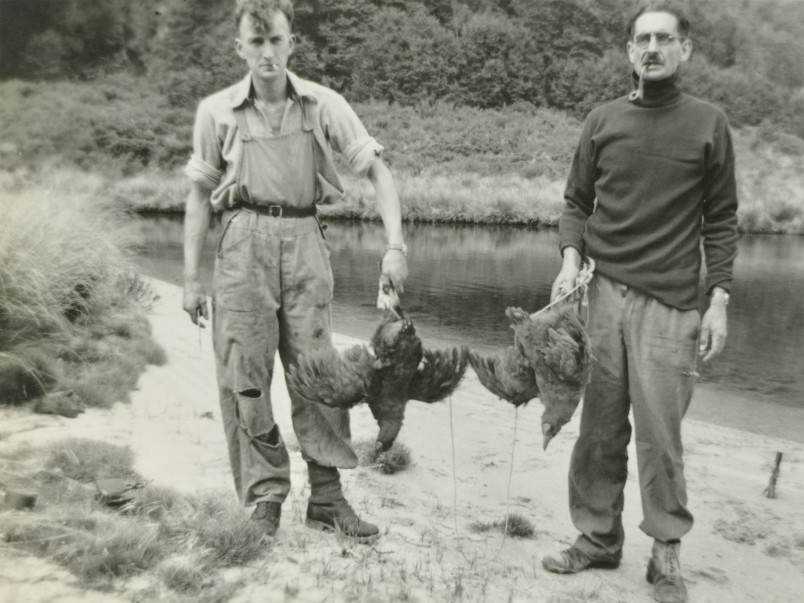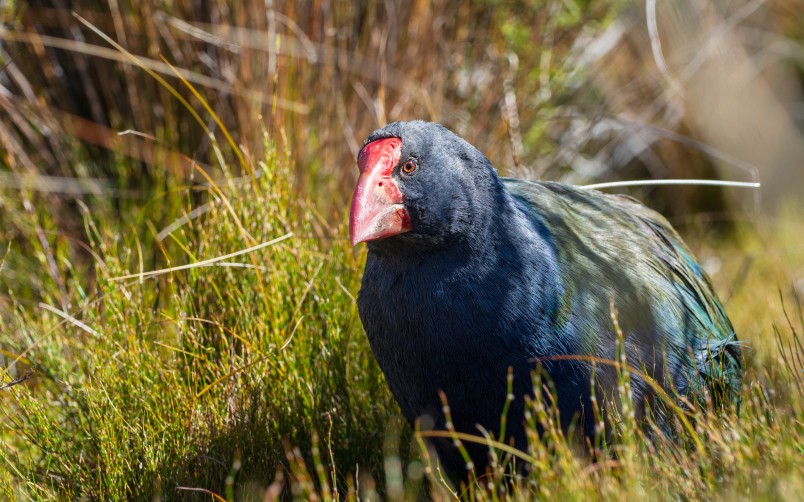
Dr Geoffrey Orbell (right) and Neil McCrostie with pair of live takahē, 1948. Courtesy Orbell family
Invercargill GP and deerstalker Geoffrey Orbell made Time magazine in April 1948 ‘in a state of ornithological ecstasy’. With three associates, he had tracked down the long ‘extinct’ takahē.
His quarry presented itself at their camp in the Murchison Mountains, at what is now known as Takahē Valley near Te Anau.

South Island takahē 'McKellar', Gouland Downs, Heaphy Track, Kahurangi National Park. Credit Jake Osborne
Prehistoric in appearance, it was a ‘living fossil’.1 In the same year, Forest & Bird’s new president, Arthur Harper, and its secretary, Robert Carter, submitted to Minister of Internal Affairs Bill Parry and Major George Yerex, head of the Department’s deer eradication campaign, that this rarity needed more than just a remote habitat to survive.

Forest & Bird press release about its “deputation” consisting of President Arthur Harper and Secretary Robert Carter, who visited Minister Parry to advocate for a takahē sanctuary, November 1948.
They sought a special takahē sanctuary, under a strict entry system to protect the birds, who were also at risk from hunting parties potting a bird for a skin with high value on black markets. Parry was sympathetic, responding immediately. A scientific reserve of more than 176,000ha, was gazetted beside Lake Te Anau.2
Under the New Zealand Deerstalkers’ Association letterhead, Orbell thanked the Forest & Bird Society for its ‘great work’ in getting takahē protected so quickly.3
The reserve became a pioneer site for the bird’s protection. More recently takahē, with many other native birds, have been granted protection to flourish in a series of other mainland sanctuaries, largely of 21st century origin, across New Zealand.4
Buy the Force of Nature book
To read more about the rediscovery of the takahē and other fascinating stories, buy a copy of Force of Nature from the Forest & Bird shop. All the book’s profits go towards the Society’s conservation mahi.
READ MORE
Blog post: Michael Pringle - Finding our stories: adventures in the archives
Article: Force of Nature book published
Extract: Arthur Harper: old-school naturalist
Extract: Carole Long: fight the policy not people
Extract: Becoming kaitiaki: Hone McGregor
Footnotes
- William G. Lee and Ian G. Jamieson (eds), The takahe: fifty years of conservation and research, Otago University Press, Dunedin, 2001, pp.20–21, introduction; D. Young, Our islands, our selves, Otago University Press, Dunedin, 2004, p.140.
- The Dominion, 27 Nov 1948; Forest & Bird statement, 26 Nov 1948, Geoffrey Orbell NZ Deerstalkers to Sec Forest & Bird, letters, Dec 1948, A.P. Harper to Minister Parry, 11 Mar 1949, ATL 84-180-55; ‘The Notornis’, Forest and Bird, Feb 1949, p.3.
- Orbell to Forest & Bird, 9 Dec 1948, ATL 84-180-55.
- ‘Takahe sanctuaries’, accessed from ww.doc.govt.nz.

